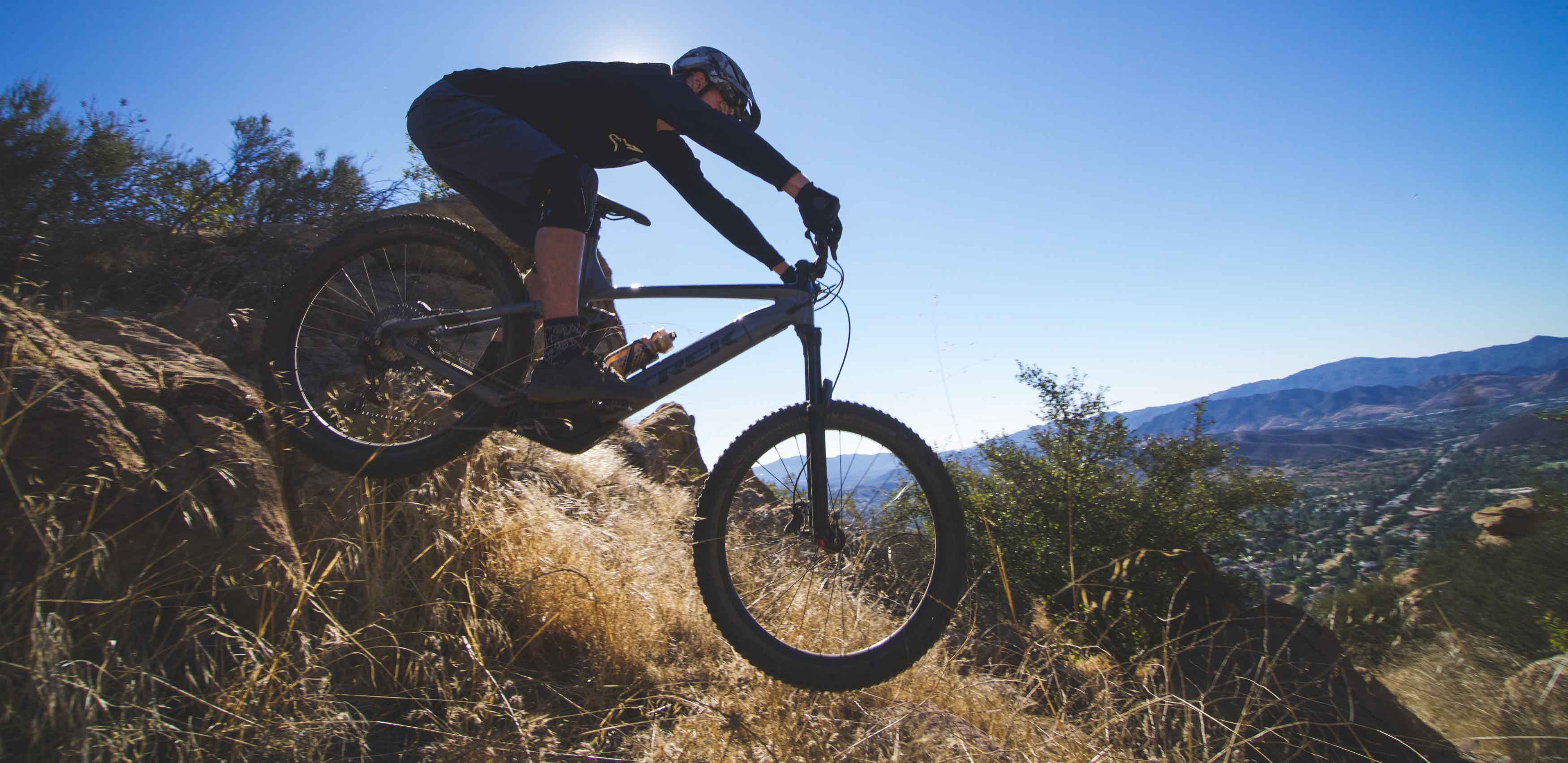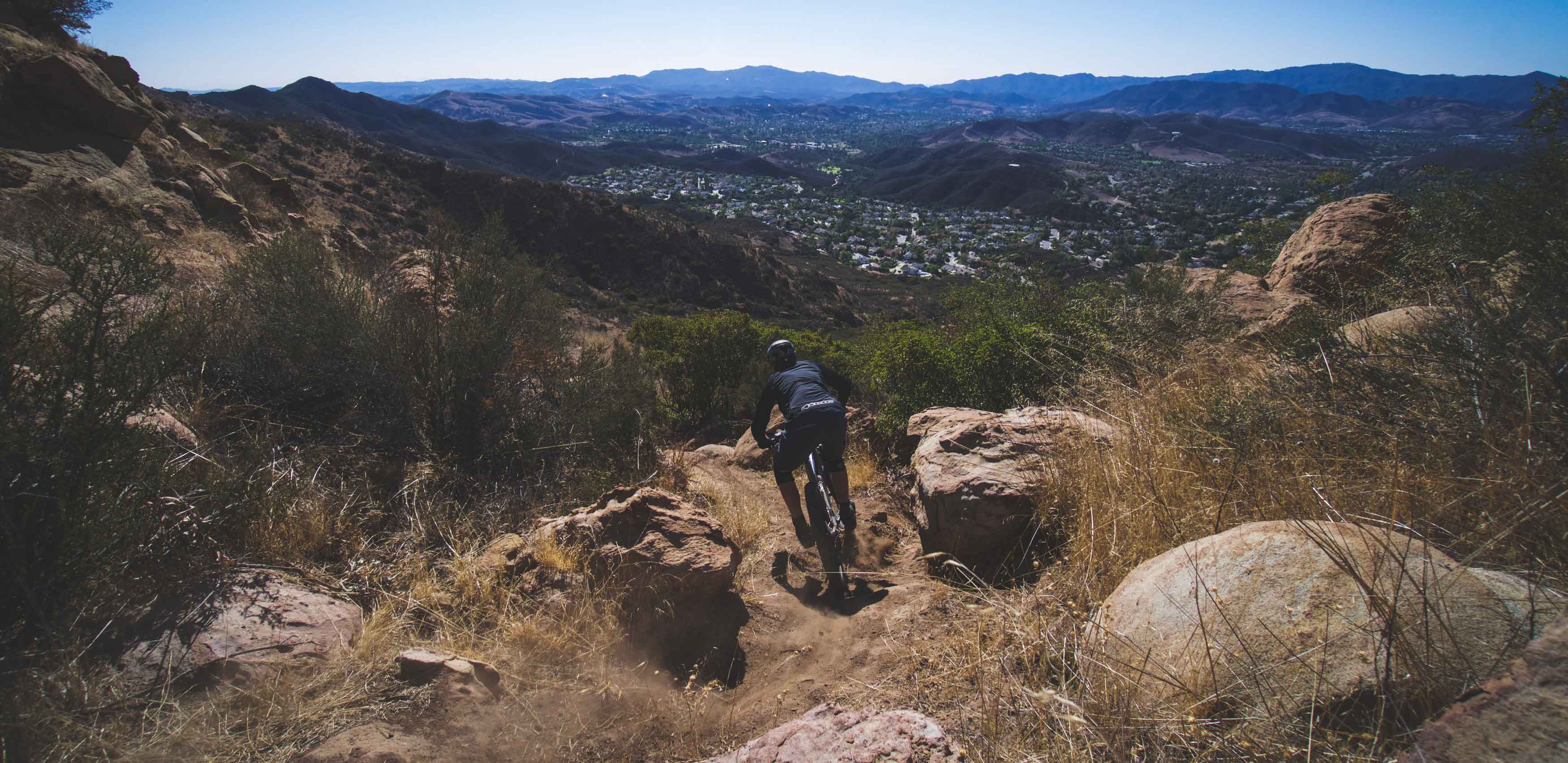
Trek Powerfly LT 7 Plus
Words & Photos by Chili Dog
Our backs laden with gear, we trudged up the hill, except for “the talent” aboard our Trek Powerfly. The sun beat down around us as we struggled for footing in the steep, loose soil. A feint whirring noise rose from the ridge behind. “This thing is too damn fun!!” yelled Sammy as he came flying past us, carrying a tripod and full backpack on his back. If I had to think of one common theme that continually came up during our time with the Powerfly, that would be it—too damn fun. The Trek Powerfly LT 7 Plus has been way more than a camera mule though. Over the months we’ve had this bike, we’ve sent it in bike parks, blazed up fire road climbs, flicked it around switchbacks, and yes, even ridden the steep ridgelines of Green River, Utah. It does it all with ease. We really don’t want to give it back.
The Lab
Trek developed the Powerfly LT 7 as a do it all machine. Within the LT name, Trek offers three levels: the LT 9.9 Plus, LT 9.7 Plus and the LT 7 Plus. At $8,999, the 9.9 is the top of the line bike with components to match. The 9.7 fills the mid range eMTB slot, with a carbon frame, Fox suspension, carbon wheels and a price tag of $5,999. The LT 7 we rode is the more affordable aluminum version, retailing at $5,499. If you’re keeping tabs, those last two are both a solid deal for an e-bike. Trek’s Powerfly LT 7 features an aluminum frame, aluminum Bontrager Line Comp 40 wheels, and a Rock Shox suspension spec. Both Powerfly LT models have 150mm of travel in the rear, and 160mm up front.

Power is provided via a Bosch Performance CX motor, Purion controller and a 500Wh Bosch battery. Maximum torque is 75nm, or about 55.3 foot-pounds. Introduced this year, Bosch’s controller has a new mode called “EMTB.” Aside from the standard three set power levels we’re accustomed to on Shimano Steps e-bikes (Eco, Trail, or Boost) EMTB mode lets the Bosch motor and software determine power output based on your pedal cadence, torque and conditions. It essentially mixes Trail and Boost settings, giving you power when you want it and dialing it down when you don’t. EMTB mode lets you focus on the ride instead of toggling between power settings all the time. Be warned however, EMTB mode will eat up battery quicker than Bosch’s Tour mode, which is like Shimano’s Trail mode.
The new Powerfly LT also sees major changes in the battery department. A side load Bosch Powertube battery drops into place from the drive side of the bike. The non-load-bearing side-accessed battery is a simple change, but it’s one that was derived from a lot of thought. A side load battery not only removes the battery from full exposure to the elements on the bottom of the down tube, but also makes it easier to replace and load in the frame.
The battery even has a nifty carrying handle that you’ll probably never use unless you’re ponying up for multiple batteries to do backcountry epics or have an issue. Nevertheless, if you don’t have power outlets near where you store your bike, or want to leave the bike in your van and just bring in the battery to charge, it’s easy to do so.

For our 165-175lb riders, the 500Wh battery has a claimed range of 105 miles in Eco mode on flatter rides, and 37.2 miles in Turbo mode however real world numbers never got that high. We never captured Bosch’s claimed range because of the elevation changes in our area. As with all battery-powered devices, elevation gain, rider weight and power modes can change actual range greatly so we definitely found that using Tour mode on longer rides was better than EMTB! Charging takes about 4.5 hours from full empty, and 2 hours from half full.
Anyone familiar with Trek ’s bikes will be instantly at home on this frame. Like their other 2019 models, it does away with the Full Floater rear suspension design, making the frame stiffer and able to accommodate 27.5+ tires. Trek’s famed ABP or Active Braking Pivot design still remains. A Rock Shox Deluxe RL handles the damping duties well.
To aid in climbing traction and stability, Trek gives the Powerfly LT a full 475 millimeters worth of chainstay, across all sizes. The bike also features a flip chip in the rear suspension linkage that lowers the BB height, slackens the head tube angle and slightly elongates the wheelbase. In the High setting, the head tube angle is 66 degrees. Flip the chip and it goes to 65.5 degrees and the bottom bracket height goes from 35cm to 34.4cm.

The Dirt
As you may have picked up by now, it didn’t take long for us to fall in love with this bike. Even after a short weekend with it at the launch camp in Mammoth Bike Park, we were pretty sure it was going to be a favorite. Trek designed the Powerfly LT to be a do it all machine, and they accomplished their goal. The only other e-bikes we’ve tested that come close to the Powerfly in all around performance are the Norco Sight VLT (review coming soon!) and the Pivot Shuttle. If you’re looking for an e-MTB that can climb, descend and handle truly technical terrain with ease, the Powerfly LT is near the top of the list with just a few other rigs.
The biggest differentiating factor with the Trek Powerfly, aside from price, are the long chainstays. At 475mm, the Powerfly’s stays are quite long. Unlike some bikes that have long stays as a result of a motor configuration or tire choice, the Powerfly’s stays were an intentional design trait.

Trek believes that a big part of the fun and practicality of an e-bike is climbing terrain too steep for a traditional MTB. As such, the long stays were chosen to aid in traction and stability while climbing. Living up to the design intentions, the Powerfly will climb just about anything you point it at without lifting the front wheel or spinning out. The combination of the 2.8 tires and long stays will have you winning countless hill climb challenges with your crew. It also handles speeds above 30mph with straight-faced confidence.
Of course, everything has a trade off. The 475mm stays prove to be slugglish and unruly on tight switchbacks where an eMTB’s weight is already a hindrance. If your bread and butter is slapping around tight corners and manualing at every chance you get, the Powerfly will be frustrating. If you want a bike that climbs and descends at breakneck speeds and stays glued to the ground, you’ve found your dream rig in the Powerfly LT 7.
With a majority of our test bikes coming with Shimano Steps 8000 powerplants, the Bosch motor with the EMTB mode was something that we truly appreciated in this bike. The Powerfly is the first bike we’ve extensively ridden with the system, and it’s now set the standard for us in the motor/controller interface category. We do miss the Shimano motor’s power mode thumb triggers however.

EMTB mode power delivery feels natural and provides the extra oomph needed in technical zones without the bucking bronco sensation typically associated with Turbo/Boost modes. The mode takes away the constant need to change power settings based on terrain, letting a rider focus on riding and not the bike. The Purion controller gives a minimalist and easy to read interface that helps the same cause. In other words, Bosch wants you to focus on riding and not their product, and they’ve succeeded.
Range on the Powerfly is right on par with the other e-bikes we’ve tested. While we haven’t taken the battery out of the bike much, the clean, integrated design looks good and has kept dust, mud and grime off the battery. One place mud and grime do find themselves however, is the very small front chainring! If you live in a very muddy area, be sure to pack a long thin flathead or similar tool to keep the small wheel spinning free.

While we received the more budget-oriented spec on our Powerfly LT 7, it performed better than many of the other e-bikes we’ve tested in the same price range. The Bontrager wheels, tires, dropper, bars and stem all performed well, even in aggressive riding. The Rock Shox Yari RL fork and Deluxe RL rear shock aren’t anything special, yet they get the job done. Aggressive riders will want to upgrade the fork, or spend the extra money for the top of the line 9.9 build to eliminate front end flex from the Yari. The Shimano four-piston brakes lack took free adjustment, but offer ample power and smooth delivery. The Shimano Deore drivetrain delivers its usual solid and reliable performance and handled the extra torque with ease.
Trek chose to spec the bike with massive 2.8” tires. Traction in loose soil is truly impressive, and the tires really shined riding in Green River, Utah and the burn areas of So Cal. On hard packed single track however, the tires are so large that they act as undamped suspension in technical rock gardens or bumpy sections of trail. The result was a bouncy, unsettled feeling on a bike that otherwise gobbled rocks like nothing. Thankfully the solution is an easy tire swap to suit whatever conditions you find yourself riding most.

The Wolf’s Last Word
If we had to go out and buy a new eMTB tomorrow, it wouldn’t be the Trek Powerfly LT 7. It would be the Powerfly LT 9.7. Both represent an impressive value, but the fully carbon 9.7 takes everything we love about the Powerfly LT 7 platform and improves it for only a few hundred dollars. We’re actually scratching our heads as to how the bikes are so similarly priced. Regardless, we know a deal when we see one!
While the rear stays may not make it the snappiest, they ensure it climbs anything you point it at. The price, overall performance and quality is also there. A lot of companies have e-bikes that look good on paper, but lack the suspension and components to actually hang under the piloting of real mountain bikers. Our Powerfly LT 7 put a smile on even the most core rider’s faces, and stood up to months of hard riding and abuse. It’s one of our favorite e-bikes for a reason!
Price: $5,499
Weight: 52 lbs
Website: Trekbikes.com

CHASSIS
Frame: Alpha Platinum Aluminum, ABP, Removable Integrated Battery (RIB)
Fork: Rock Shox Yari RL (160mm)
Rear Shock: Rock Shox Deluxe RL, Performance, Evol, (150mm)
POWER PLANT
Drive unit: Bosch Performance CX
Battery pack: Bosch PowerTube 500Wh
Controller: Bosch Purion
COCKPIT
Shifter: Shimano Deore XT
Brakes: Shimano MT520 4-piston
Handlebar: Bontrager Rhythm Comp
Stem: Bontrager Rhythm Comp
Seatpost: Bontrager Line
Seat: Bontrager Arvada
WHEELS
Hubs: Bontrager
Rims: Bontrager Line Comp 40
Tires: Bontrager XR4 Team Issue 27.5×2.80˝
DRIVETRAIN
Chainwheel: Shimano FC-E8000, 34T
Cassette: Shimano SLX, 11-46T
Cranks: Race Face Aeffect
Chain: Shimano CN-HG600
Rear Derailleur: Shimano Deore XT M8000, Shadow Plus

We Dig
Climbs Anything
Smooth Suspension
All Around Confidence
Great Value
We Don’t
Long Chainstays
Small Chainring in Muddy Conditions
Fork Spec
Leave A Comment & Win Free Schwag
Want to win some free schwag? Leave a comment and vote up the most thoughtful comments and each month we’ll pick a winner. The person with the smartest and most helpful replies will earn some sweet new gear. Join the Pack
